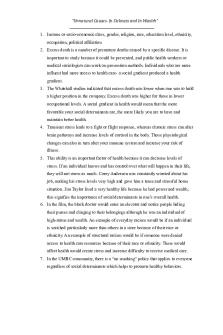Causes OF Unbalancie IN Rotating Masses PDF

| Title | Causes OF Unbalancie IN Rotating Masses |
|---|---|
| Author | Anonymous User |
| Course | Mechanics of Machines |
| Institution | Universiteti Marin Barleti |
| Pages | 2 |
| File Size | 84.8 KB |
| File Type | |
| Total Downloads | 90 |
| Total Views | 167 |
Summary
Causes of unbalance in rotating masses...
Description
BALANCING OF ROTATING MASSES UNBALANCE The condition which exists in a rotor when vibratory force or motion is imparted to its bearings as a result of centrifugal forces is called unbalance or the uneven distribution of mass about a rotor’s axis – rotating centerline. The existence of the unbalance is produced by rotary or reciprocating machine components due to unbalanced inertia forces associated with the moving masses Reasons Why Machines Components become unbalanced
Unsymmetrical shape of rotor due to machining error e.g. pulley Material used is not uniform especially in castings Deformation has occurred due to distortion An eccentricity exists due to a gap or fitting or weld Non uniformity exists in keys and key seats Non uniformity in the mass of flange Unbalance due to unequal distribution of masses and their distances In engines vibration also occur due to unsynchronized firing – misfiring
Rotating rotors which are unbalanced causes the following problems The whole machine vibrates Machine produce noise during operation bse of vibration Bearings exhibit abrasion and shorten the life of the machine BALANCING Balancing is defined as the process of designing or modifying machinery so that the unbalance is reduced or unbalanced forces are minimized to acceptable level or if possible eliminated Balancing is the process of attempting to improve the mass distribution of a body so that it rotatesin its bearings without unbalanced centrifugal forces. Balancing means a process of restoring machine which has unbalance to a balance state by adjusting the mass distribution of the rotor about its axis of rotation Types of balancing Static balance Dynamic unbalance Static Balancing - A rotating mass is said to be statically balanced if the rotating mass can rest without turning, at any angular position in its bearings. This condition is attained when the sum of the centrifugal forces on the rotating mass is zero in any radial direction. OR
Static balancing is a balance of forces due to action of gravity A body is said to be in static balance when its centre of gravity is in the axis of rotation Dynamic Balancing - A rotating mass is said to be dynamically balanced when it does not vibrate in its running state. To make a rotating mass dynamically balanced, it must first be statically balanced OR
Dynamic balance is a balance due to the action of inertia forces (i)
(ii)
A body is said to be in dynamic balance when the resultant moments or couples, which arise due to acceleration of different moving parts is equal to zero – there is no resultant centrifugal force and no resultant couple acting on the shaft If the conditions of dynamic balance are met, the condition of static balance are also met
Mass Balancing is necessary for
Quiet operation High speed Long life of the bearing Operator’s comfort Controls free of malfunctioning therefore quality feel
Benefit of Balancing
Increase quality of operation Minimize vibration Minimize audible and signal noises Minimize structural fatigue stresses Increase bearing life span Minimize operator discomfort and fatigue Reduce power loss
Rotating Components or Machine Parts that require Balancing a) Pulley and gear shaft assembly b) Starter armature c) High speed machine-tools and precision shafts d) Flywheels e) Impellers f) Centrifugal rotors g) Electric motors rotors
h) i) j) k) l) m)
Fan and blowers Turbochargers Compressor rotors Crank shafts Grinding wheels Steam and Gas turbines n) Wheels of vehicles...
Similar Free PDFs

balancing of rotating masses
- 25 Pages

Balancing of Reciprocating Masses
- 11 Pages

Table des masses volumiques
- 2 Pages

Causes of Chinese revolution
- 3 Pages

Causes of WWII - Philosophy
- 2 Pages

Causes of WWII worksheet
- 2 Pages

Causes of Revolution
- 3 Pages

LN 10 - Rotating unbalance
- 5 Pages

Causes of WW1 essay outline
- 5 Pages
Popular Institutions
- Tinajero National High School - Annex
- Politeknik Caltex Riau
- Yokohama City University
- SGT University
- University of Al-Qadisiyah
- Divine Word College of Vigan
- Techniek College Rotterdam
- Universidade de Santiago
- Universiti Teknologi MARA Cawangan Johor Kampus Pasir Gudang
- Poltekkes Kemenkes Yogyakarta
- Baguio City National High School
- Colegio san marcos
- preparatoria uno
- Centro de Bachillerato Tecnológico Industrial y de Servicios No. 107
- Dalian Maritime University
- Quang Trung Secondary School
- Colegio Tecnológico en Informática
- Corporación Regional de Educación Superior
- Grupo CEDVA
- Dar Al Uloom University
- Centro de Estudios Preuniversitarios de la Universidad Nacional de Ingeniería
- 上智大学
- Aakash International School, Nuna Majara
- San Felipe Neri Catholic School
- Kang Chiao International School - New Taipei City
- Misamis Occidental National High School
- Institución Educativa Escuela Normal Juan Ladrilleros
- Kolehiyo ng Pantukan
- Batanes State College
- Instituto Continental
- Sekolah Menengah Kejuruan Kesehatan Kaltara (Tarakan)
- Colegio de La Inmaculada Concepcion - Cebu






